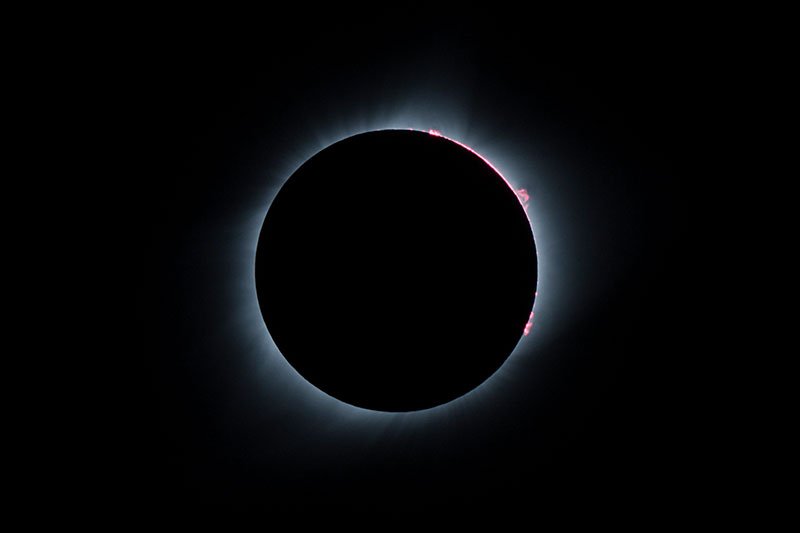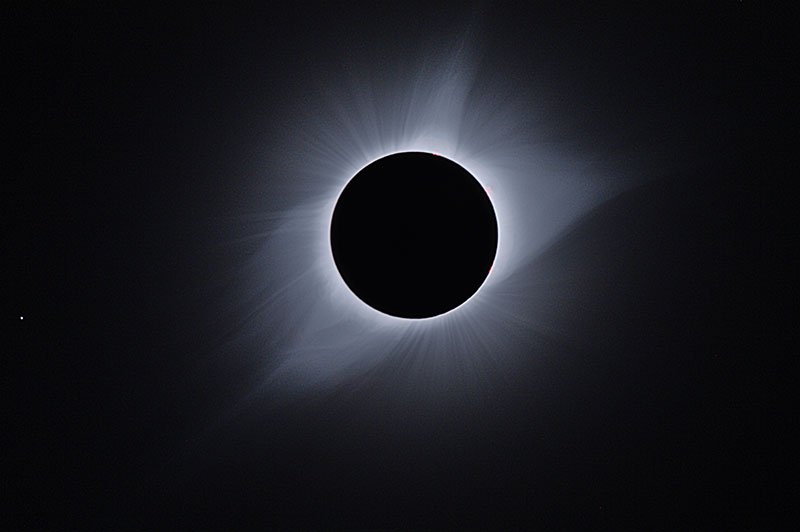
Countdown to the Eclipse: Three Weeks Out!
What is a total eclipse like?
We’re now three weeks from the April 8 total solar eclipse. In my first blog post about this eclipse, I suggested that you plan where to go to see this eclipse, and I provided a link to a map to help you in your selection. I also showed how you may be able to see all five naked-eye planets while in totality. In my second blog post about this eclipse, I combated the common misconception that a nearly total solar eclipse is about the same as a total solar eclipse (THEY ARE NOT THE SAME—PLEASE GO TO TOTALITY IF YOU CAN). I also discussed how to safely view the partial phases of the eclipse before and after totality. One safety tip that I overlooked in that blog post was if you are using a telescope with a finder telescope to view the eclipse, be sure to cover the finder telescope. You don’t want anyone to look through the finder telescope pointed directly at the sun during the partial phases of the eclipse.
In this blog post, I discuss what to expect during totality. When totality arrives, be sure to remove your eclipse glasses! Of course, it will get dark but not as dark as midnight. If the sky is clear, it will get dark like deep twilight, and many of the brighter stars will be visible. However, how many stars you see will depend upon how clear the sky is. At my first total solar eclipse, I didn’t see any stars because the sky was filled with thin clouds. We saw the eclipse well enough—we just didn’t see any stars. There won’t be any bright stars near the sun in the sky during this eclipse, which will probably make picking out the five naked-eye planets easier. Quite a bit left of the sun will be Orion, as well as some of the brighter winter sky stars, such as Aldebaran, Capella, Castor, and Pollux. From where I intend to be in Indiana, Procyon and Sirius ought to be low in the east-southeast. For those viewing in Texas, some of those stars will be below the horizon. On the other hand, the summer triangle (Vega, Deneb, and Altair) likely will be visible low in the northwest in Texas, though they will be a bit difficult where I will be.
During totality, it is safe to look directly at the sun, but only during totality. On the edge of the sun, you will see blood-red prominences . They likely will appear as loops. The prominences will be visible more on the left side of the sun at first, but as the moon slides past the sun going from right to left, prominences on the right side of the sun will be more visible toward the end of totality. Farther out from the sun will be the pearly-white corona . The corona will extend at least a solar diameter outward. Look for streamers in the corona that trace out the field lines of the sun’s magnetic field, much as iron filings placed over a bar magnet line up with the magnet’s field lines. Binoculars will be very helpful for viewing prominences and the corona. In many respects, binoculars are better for viewing total solar eclipses than telescopes are. So be sure to bring along binoculars and share them during totality.
If you wish to photograph prominences and the corona, I suggest a long focal length lens. A 400-mm lens probably would be best. Without a telephoto lens or zoom, you may be disappointed with how small the sun appears in the sky. On the other hand, a wide-angle view with a small corona, dark sky, landscape, and people can make a grand photograph . When taking images with a long focal length, experiment with the exposure times. With digital cameras, most exposures will be much less than a second. Longer exposures will capture the corona but overexpose the prominences. A shorter exposure will underexpose the corona but reveal the prominences in detail. But the human eye sees both at the same time. This is an example of how marvelous God made our eyes, in some respects superior to any camera that man can make.
This is an example of how marvelous God made our eyes, in some respects superior to any camera that man can make.
But don’t spend all your time taking photographs. Some people make the mistake of wanting to capture the moment for posterity so much that they fail to drink in the experience, leaving them with little memory of the event. Look around you at the eerie appearance of everything. If you have good exposure in all directions, you will see a 360-degree sunset around you. Day animals will tend to prepare for night by going to sleep. Nocturnal animals, such as bats, come out and crickets can be heard (though being so early in spring, crickets probably won’t be around for many of us). And the effect on people can be amazing. Many people shout for joy, but not me. I shut up. I am so intent on taking in the experience that I am dumbstruck. Yeah, I know that people who know me find that difficult to believe—we could probably charge admission just for that.
In those last few minutes before totality and for a few minutes afterward, look for shadow bands. Place a large white background, such as a sheet or poster board on the ground. For a few minutes before and after totality, wiggly dim lines will move in the direction of the motion of the moon’s shadow. Where I will be, that will be southwest to northeast. Shadow bands have low contrast, which makes them easy to miss and difficult to photograph, but try videoing them if you see them. My experience has been that even very thin clouds will make shadow bands difficult to see.
It is important to be aware of the time—you don’t want to look at the sun before totality begins or get caught looking at the sun while totality ends. If you are in a group, it is a good idea to appoint a responsible person to monitor the time and shout a countdown to the beginning of totality and another countdown to the end of totality. The map I linked in the first eclipse blog post will tell you exactly when totality begins and ends (second and third contact) at your location. You may also download an app on your phone too.

Answers in Genesis is an apologetics ministry, dedicated to helping Christians defend their faith and proclaim the good news of Jesus Christ.
- Customer Service 800.778.3390
- © 2024 Answers in Genesis



